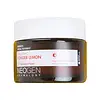What's inside
What's inside
 Key Ingredients
Key Ingredients

 Benefits
Benefits

 Concerns
Concerns

 Ingredients Side-by-side
Ingredients Side-by-side

Water
Skin ConditioningGlycerin
HumectantCaprylic/Capric Triglyceride
MaskingPanthenol
Skin ConditioningButylene Glycol
HumectantPropanediol
SolventNiacinamide
Smoothing1,2-Hexanediol
Skin ConditioningDiisostearyl Malate
EmollientCoco-Caprylate/Caprate
EmollientHydrogenated Poly(C6-14 Olefin)
EmollientMalva Sylvestris Flower Extract
Skin ConditioningStearyl Alcohol
EmollientNeopentyl Glycol Diheptanoate
EmollientHydrogenated Olive Oil Lauryl Esters
Emulsion StabilisingPolyglyceryl-2 Stearate
EmulsifyingCetyl Alcohol
EmollientGlyceryl Stearate
EmollientHydroxyethyl Acrylate/Sodium Acryloyldimethyl Taurate Copolymer
Emulsion StabilisingPolyglyceryl-10 Laurate
Skin ConditioningHydrogenated Lecithin
EmulsifyingDimethicone
EmollientAcrylates/C10-30 Alkyl Acrylate Crosspolymer
Emulsion StabilisingTromethamine
BufferingAnthemis Nobilis Flower Oil
MaskingEthylhexylglycerin
Skin ConditioningXanthan Gum
EmulsifyingThuja Occidentalis Leaf Oil
MaskingAdenosine
Skin ConditioningSorbitan Isostearate
EmulsifyingLactococcus Ferment Lysate
Skin ConditioningCoptis Japonica Extract
AntimicrobialAscorbic Acid
AntioxidantCitrus Aurantium Amara Flower Extract
RefreshingCollagen Extract
Skin ConditioningCyanocobalamin
Skin ConditioningMaltodextrin
AbsorbentMagnesium Ascorbyl Phosphate
AntioxidantAscorbyl Tetraisopalmitate
AntioxidantSodium Starch Octenylsuccinate
AbsorbentCalcium Pantothenate
Sodium Ascorbyl Phosphate
AntioxidantPolyglyceryl-10 Diisostearate
EmulsifyingGardenia Florida Fruit Extract
Skin ConditioningSodium Polyphosphate
Tocopheryl Acetate
AntioxidantPyridoxine Hcl
Skin ConditioningSodium Ascorbate
AntioxidantLecithin
EmollientPolysorbate 20
EmulsifyingMenadione
MaskingTricalcium Phosphate
AbrasiveSilica
AbrasiveCopper Tripeptide-1
Skin ConditioningBiotin
AntiseborrhoeicPyridoxine
Skin ConditioningFolic Acid
Skin ConditioningTocopherol
AntioxidantTripeptide-1
Skin ConditioningRiboflavin
Cosmetic ColorantThiamine Hcl
MaskingPalmitoyl Tripeptide-1
Skin ConditioningLinoleic Acid
CleansingTripeptide-2
Skin ConditioningHexapeptide-1
Skin ConditioningBeta-Carotene
Skin ConditioningAcetyl Hexapeptide-8
HumectantPalmitoyl Tetrapeptide-7
Skin ConditioningPalmitoyl Pentapeptide-4
Skin ConditioningHexapeptide-9
Skin ConditioningNonapeptide-1
Skin ConditioningDisodium EDTA
Water, Glycerin, Caprylic/Capric Triglyceride, Panthenol, Butylene Glycol, Propanediol, Niacinamide, 1,2-Hexanediol, Diisostearyl Malate, Coco-Caprylate/Caprate, Hydrogenated Poly(C6-14 Olefin), Malva Sylvestris Flower Extract, Stearyl Alcohol, Neopentyl Glycol Diheptanoate, Hydrogenated Olive Oil Lauryl Esters, Polyglyceryl-2 Stearate, Cetyl Alcohol, Glyceryl Stearate, Hydroxyethyl Acrylate/Sodium Acryloyldimethyl Taurate Copolymer, Polyglyceryl-10 Laurate, Hydrogenated Lecithin, Dimethicone, Acrylates/C10-30 Alkyl Acrylate Crosspolymer, Tromethamine, Anthemis Nobilis Flower Oil, Ethylhexylglycerin, Xanthan Gum, Thuja Occidentalis Leaf Oil, Adenosine, Sorbitan Isostearate, Lactococcus Ferment Lysate, Coptis Japonica Extract, Ascorbic Acid, Citrus Aurantium Amara Flower Extract, Collagen Extract, Cyanocobalamin, Maltodextrin, Magnesium Ascorbyl Phosphate, Ascorbyl Tetraisopalmitate, Sodium Starch Octenylsuccinate, Calcium Pantothenate, Sodium Ascorbyl Phosphate, Polyglyceryl-10 Diisostearate, Gardenia Florida Fruit Extract, Sodium Polyphosphate, Tocopheryl Acetate, Pyridoxine Hcl, Sodium Ascorbate, Lecithin, Polysorbate 20, Menadione, Tricalcium Phosphate, Silica, Copper Tripeptide-1, Biotin, Pyridoxine, Folic Acid, Tocopherol, Tripeptide-1, Riboflavin, Thiamine Hcl, Palmitoyl Tripeptide-1, Linoleic Acid, Tripeptide-2, Hexapeptide-1, Beta-Carotene, Acetyl Hexapeptide-8, Palmitoyl Tetrapeptide-7, Palmitoyl Pentapeptide-4, Hexapeptide-9, Nonapeptide-1, Disodium EDTA
 Reviews
Reviews

Ingredients Explained
These ingredients are found in both products.
Ingredients higher up in an ingredient list are typically present in a larger amount.
1,2-Hexanediol is a synthetic liquid and another multi-functional powerhouse.
It is a:
- Humectant, drawing moisture into the skin
- Emollient, helping to soften skin
- Solvent, dispersing and stabilizing formulas
- Preservative booster, enhancing the antimicrobial activity of other preservatives
Ascorbic Acid is is pure Vitamin C. This form makes up the largest amount of vitamin C found naturally in our skin.
Not only is vitamin C great for your overall health and immune system, it also has plenty of benefits on your skin.
Vitamin C is best used for brightening skin. It improves dark spots, acne scars, and hyperpigmentation. This is because it blocks the process of skin darkening when exposed to UV.
Remember: Vitamin C should not replace sunscreen!
Your skin uses vitamin C to build collagen. Collagen is one key component in having a strong skin barrier and plump skin. Vitamin C also plays a role in regulating collagen, thus making it effective in improving wrinkles and fine lines.
Ascorbic acid shows potent antioxidant activity. As an antioxidant, it helps fight free-radicals. Free-radicals are molecules that may damage your skin cells. These antioxidants also protect skin against UV damage.
The best formulations include Vitamin E and/or ferulic acid. These two ingredients help stabilize and provide a boost in the benefits of ascorbic acid. This is because ascorbic acid becomes unstable when exposed to UV and air. In fact, you can tell your ascorbic acid has oxidized when it turns an orange-yellow color.
Ascorbic acid is generally compatible with other ingredients. However, using ascorbic acid with other active ingredients might cause irritation. Two ingredients: copper ions and benzoyl peroxide, will inactivate ascorbic acid completely.
Read more about other types of Vitamin C:
Foods rich with vitamin C include oranges, strawberries, broccoli, bell peppers, and more. When consuming Vitamin C, your skin receives a portion of the nutrients.
Learn more about Ascorbic AcidPanthenol is a common ingredient that helps hydrate and soothe the skin. It is found naturally in our skin and hair.
There are two forms of panthenol: D and L.
D-panthenol is also known as dexpanthenol. Most cosmetics use dexpanthenol or a mixture of D and L-panthenol.
Panthenol is famous due to its ability to go deeper into the skin's layers. Using this ingredient has numerous pros (and no cons):
Like hyaluronic acid, panthenol is a humectant. Humectants are able to bind and hold large amounts of water to keep skin hydrated.
This ingredient works well for wound healing. It works by increasing tissue in the wound and helps close open wounds.
Once oxidized, panthenol converts to pantothenic acid. Panthothenic acid is found in all living cells.
This ingredient is also referred to as pro-vitamin B5.
Learn more about PanthenolWater. It's the most common cosmetic ingredient of all. You'll usually see it at the top of ingredient lists, meaning that it makes up the largest part of the product.
So why is it so popular? Water most often acts as a solvent - this means that it helps dissolve other ingredients into the formulation.
You'll also recognize water as that liquid we all need to stay alive. If you see this, drink a glass of water. Stay hydrated!
Learn more about Water